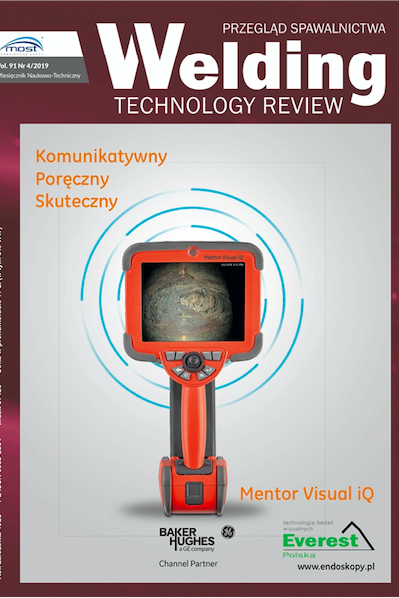Robotic Spot Welding of DOCOL 1200M Steel
Main Article Content
Abstract
The paper presents robotic spot resistance welding technologies for DOCOL 1200M steel with a thickness of 1.8 mm. DOCOL 1200M steel with a martensitic structure is intended mainly for the production of car bumpers, side beams and other elements ensuring the safety of the user of motor vehicles. The test joints were made on a robotic station equipped with a KUKA KR180 robot and a welding from ARO. The obtained welded joints were subjected to macro and microscopic metallographic tests, hardness measurement and strength tests. It has been shown that for properly selected resistance spot welding, DOCOL 1200M steel joints with a satisfactory strength level can be obtained.
Downloads
Article Details
Creative Commons CC BY 4.0 https://creativecommons.org/licenses/by/4.0/
Welding Technology Review (WTR) articles are published open access under a CC BY licence (Creative Commons Attribution 4.0 International licence). The CC BY licence is the most open licence available and considered the industry 'gold standard' for open access; it is also preferred by many funders. This licence allows readers to copy and redistribute the material in any medium or format, and to alter, transform, or build upon the material, including for commercial use, providing the original author is credited.
References
Grajcar A., Różański M., Spawalność wysokowytrzymałych stali wielofazowych AHSS, Welding Technology Review, 2014, Vol. 3, 22-27. DOI: https://doi.org/10.26628/ps.v86i3.103
Flaxa V., Shaw J., Material applications in ULSAB-AVC, Steel Grips, 2003, Vol. 1(4), 255-261.
Krajewski S., Nowacki J., Mikrostruktura i właściwości stali o wysokiej wytrzymałości AHSS, Welding Technology Review, 2011, Vol. 7, 45-50. DOI: https://doi.org/10.26628/ps.v83i7.532
Stano S., Spawanie laserowe blach o zróżnicowanej grubości przeznaczonych na półfabrykaty karoserii samochodowych typu tailored blanks, Biuletyn Instytutu Spawalnictwa, 2005, Vol. 2, 24-28.
Chen B., Yu H., Hot ductility behaviour of V-N and V-Nb microalloyed steels, International Journal of Minerals, Metallurgy and Materials, 2012, Vol. 19 (6), 525. DOI: https://doi.org/10.1007/s12613-012-0590-6
Żuk M., Górka J., Czupryński A., Adamiak M., Properties and structure of the weld joints of quench and tempered 4330V steel, Metalurgija, 2016, Vol. 55(4), 613-616.
Shipitsyn S., Babaskin Y., Kirchu I., Smolyakova L., Zolotar N., Microalloyed steel for railroad wheels. Steel in Translation, 2008, Vol. 38(9), 782-785. DOI: https://doi.org/10.3103/S0967091208090222
Godwin K., Yong O., Microstructure and fatigue performance of butt-welded joints in advanced high-strength steels. Materials Science & Engineering, 2014, A 597, 342-348. DOI: https://doi.org/10.1016/j.msea.2014.01.007
Siewer A., Krastel K., Fiber Laser Seam Stepper Replacing Resistance Spot-Welding. A cost-effective laser based tool to conventional welding technology, Laser Technik Journal, 2014, Vol. 4, 52-55. DOI: https://doi.org/10.1002/latj.201400043
Górka J., Ozgowicz A., Próby spawania laserowego niskostopowej wysokowytrzymałej stali o strukturze martenzytycznej, Welding Technology Review, 2016, Vol. 88(5), 24-27. DOI: https://doi.org/10.26628/ps.v88i5.607
Senkara J., Współczesne stale karoseryjne dla przemysłu motoryzacyjnego i wytyczne technologiczne ich zgrzewania, Welding Technology Review, 2019, Vol. 81(11), 3-7.
Kaczmarek W., Panasiuk J., Zrobotyzowane procesy zgrzewania, Control Engineering, 2015, Vol. 5, 50-66.
Zhang X.Y., Zhang Y.S., Chen G.L., Research on Weldability for Dual-Phase Steels Using Servo Gun Spot Welding System, Journal Key Engineering, 2007, Material no 1597. DOI: https://doi.org/10.4028/0-87849-456-1.1597
Kowieski S., Mikno Z., Pietras A., Zgrzewanie nowoczesnych stali o wysokiej wytrzymałości, Welding Technology Review, Vol. 56(3), 46-51.
Poradnik inżyniera spawalnictwo, red. Jan Pilarczyk, Wydawnictwo Naukowe PWN, 2017.
